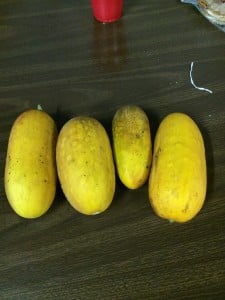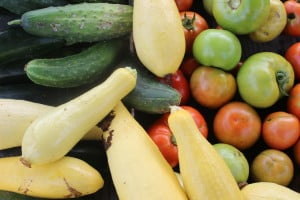Happy September, Grow Appalachians! Holly from HQ here. A lot has changed for me in the past two weeks, the most noticeable being that I finished my VISTA term last week (shew, that went fast!!) and am now learning to adjust to life as a “big girl” staff member. No worries; I think I’m going to enjoy it!
This week’s post might be a little overly philosophical for some, so allow for a bit of a personal explanation: In my workspace, I have a picture of a sankofa (the featured image), a Ghanaian symbol that translates, almost literally, into “reach back and get it”, which epitomizes both looking forward, but not forgetting to look back where you came from. This is, in my opinion, a component of any kind of site coordination/management that I think is equally necessary and overlooked, and that is: How do you plan ahead for next year, while taking adequate time to reflect on the current year?
It’s definitely not a surprise, but this growing season has been probably one of the most challenging we’ve seen since Grow Appalachia started six years ago. Mother Nature has been more than unkind to us, gardens have been washed out, dried out, folks have lost substantial harvest (and sadly, a lot more), and are having to start over entirely. With all of the difficulties and setbacks that have occurred, it’s easy to write this year off as a failure and just jump into 2016 planning, because, let’s face it, anything is better than this year, right? As I mentioned earlier, I think it’s important to do both.
Before you start into 2016 planning, think about a few things from this year:
–What were the significant challenges or obstacles from this year? By addressing what didn’t exactly “go right”, when you go into planning for next year, you are aware of those challenges and can discuss with your colleagues a plan to how those challenges will be met and (hopefully) eliminated. On the flip side of that, it’s also important to recognize and realize that, unfortunately, there are some challenges that you cannot control, such as weather.
–What were some successes from this year? I’m sure you’ve heard this before: when going in for a performance review at work or something like that, you’re told 100 things you’re doing well and then 1 thing you’re not doing well. What do you focus your attention on? That ONE thing you’re not doing well. Especially with this year, it is so important to celebrate your site’s successes, no matter how grand or not! Did you have a good number of returning families? Did one of your participants approach you, thankful for having learned something they never knew before? Are children attending workshops? Were you able to share some of your harvest with those who may have suffered loss from all the flooding earlier this year? Did you have any harvest at all, and if you did, did you have anything strange or unusual “crop” up? (A few months ago we got this picture from Lori in McDowell County, WV- she was thinking dinosaurs at one point!). Anything is fair game!! Also, be sure to encourage your participants regularly- they probably need it as much as you do!
-Are you thinking about site-generated revenue? In layman’s terms, are you thinking of ways to put some income back into your site? Although your participants selling produce at the market is fantastic, and we definitely want folks to continue doing so, we at HQ have also been pushing diverse site-generated revenue sources for the past couple of years or so. Consider adding a value-added branch to your site; value-added products can include jams, salsa, hot sauce, sauerkraut…oh, you get the idea! If you keep bees, BINGO! Honey is a great value-added product! A few of our rockstar sites in the value-added world are Scott County, GH17, and The David School, so if you’re not sure where to start, start with them and check out what they’re doing! If you don’t have the facilities or means to otherwise start a value-added enterprise, consider selling non-produce products, such as calendars, plants, and compost. Be creative! Any way you can put $ back into your program is a worthwhile investment (Just make sure it’s legal!)
Taking site-generated revenue one step further…
-Are you thinking about site sustainability? Just to clarify, I’m not talking about “going green”. Sustainability, in this sense, is asking yourself how you will keep your program going when Grow Appalachia-related funds are no longer available (It’s sad to think about, but it’s the truth- we won’t be around forever!) The first and foremost point to consider goes back to site-generated revenue- creating a supplemental income stream, researching and applying for additional grant funding that supports general operating costs, and leveraging as many community resources as possible. It is also wise to create a leadership succession plan; that is, identifying a strong successor to carry on your work in the event of your stepping down, and assuring he or she has all the proper documentation and training necessary to carry out your duties effectively and responsibly. As a just-transitioned-out VISTA, I cannot stress the importance of this enough.
Finally, if you have any questions, about ANYTHING I’ve just covered, or about anything else, please let one of us at HQ know. We are more than happy to help you come up with a plan that works for you!
All right, now that the gears in your head are turning a bit, let’s talk about next year…For those of you that are Grow Appalachia site coordinators, good news: we are now currently accepting proposals for 2016! Earlier is better than later, so please get them in as soon as possible, and if you didn’t get the email with the proposal guidelines, let us know! Some things to consider going into the new year:
-Please be cognizant of the number of families you are wanting to work with, and whether or not you will be able to successfully recruit and maintain that number. A big issue we’ve had this year is a lot of families not staying committed to the program- how will you assure that your family numbers are what you initially outlined in your proposal? Consider some sort of incentive to reward those that faithfully participate.
-Partner with as many community organizations as possible! (Remember leveraging resources?) Be intentional about reaching out into the community. It’s encouraging to us when we look over your reports and we see that section totally full; that means you’re making connections, gaining insight and additional resources, and tapping into the power of a local economy! If your site services more than one county, consider partnering with organizations in those surrounding counties as well.
-Be realistic with your request. Of course, we want you to have goals and “dream big”, but please keep in mind that while we have still been generously funded, it is not at the levels as in the past. In other words, we have less money to work with and the same amount of proposals coming in. A rule of thumb for us, in terms of finances, is $1000/family.
All of this planning and thinking ahead can seem intimidating, pointless even. But Brian Tracy puts it this way: “Every minute spent in planning saves as many as ten minutes in execution.” That being said, are you making an investment in your planning time? As always, if you have any questions, give us a shout!
Hope to hear from some of you very soon, and until next time, let’s have some actual fall weather, shall we? (what is this 90’s crap?)





Leave A Comment